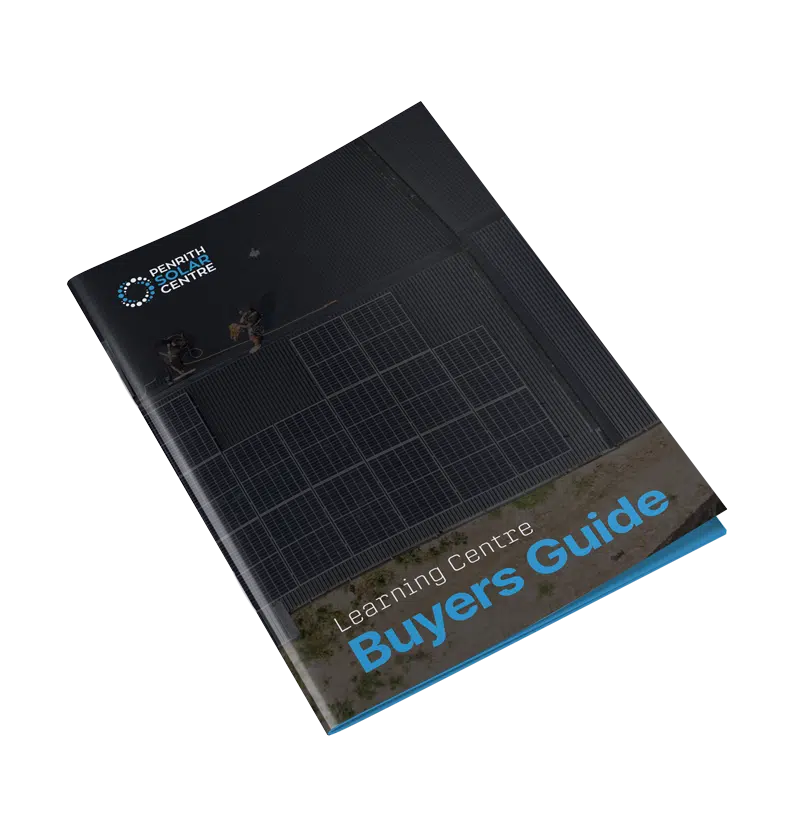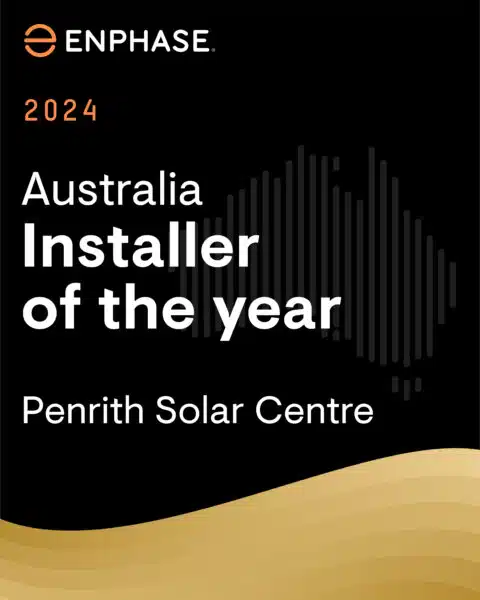
If you’re thinking about solar, you probably picture panels on your roof. But what if your roof isn’t ideal for solar panels? That’s where ground mount solar comes in.
Ground mount solar is a great option when rooftop solar isn’t possible.
At Penrith Solar Centre, we know a thing or two about ground mount solar. Well, we know a thing or two about rooftop solar as well, but that’s not what this article is about.
In this guide, you will learn:
- When Does Ground Mount Solar Make Sense?
- Benefits of Ground Mount Solar
- Drawbacks of Ground Mount Solar
- The Installation Process
- Costs of Ground Mount Solar
- Council Approval and Engineering Requirements
By the end of this article, you’ll understand when ground mount solar makes sense, how it works, what it costs, and what you need to know before installing it.

When Does Ground Mount Solar Make Sense?
At Penrith Solar Centre, we’re proud to offer ground mount solutions by our good friends at Schletter. Schletter is the solar mounting system manufacturer that we use for our rooftop solar systems.
While they offer great solutions for rooftop solar, they specialise in ground mount solar as well. So, Schletter has a great solution for ground mount solar systems. It’s a single post setup, it’s quite quick to install, it’s aesthetically pleasing, and it has a 25-year warranty.
Ground mount solar systems are a good choice in the following situations:
- When your roof can’t handle the weight of a solar system.
- When your roof is shaded fully, or its angle isn’t quite right for solar.
- If you have extra land, a ground mount system could be a smart way to use that space.
- Some people even use these systems to cover a spot to park their car, so you get shade and solar power at the same time.
If you’re interested in learning a bit more about solar mounting systems, you might want to check out the following article titled, What is a Solar Mounting System?

Benefits of Ground Mount Solar
Ground mount solar has several advantages.
The biggest benefit of ground mount solar is that you can generally pick which way you want to install it. There’s so much flexibility in how you place it.
You can position the panels to face the perfect direction to catch the most sunlight based on your energy use. You might set them up to face north or adjust them to split east and west.
Ground mount solar is also great for land that can’t be used for anything else, like flood-prone areas. You turn unusable land into a power source for your home.
You can make the system as big as your land allows, which means you can generate more power compared to a rooftop system. If you have the space for it. This makes ground mounted solar a great solution for rural areas where property owners have a little more real estate.
Because it’s closer to the ground, it’s easier to clean and maintain. When your panels are within reach, you’re more likely to keep them clean, which helps them work more efficiently.
Another benefit is that you can get creative with how you use ground mount solar. You can add battery storage, build awnings, or even pour slabs for extra structures. This system opens up possibilities that rooftop solar doesn’t have.
If you’re interested in learning a bit more about the process of choosing components for your solar system, you might want to check out the following article titled, How to Shop for a Solar System.

Drawbacks of Ground Mount Solar
While ground mount solar has many benefits, it also has downsides.
One of the main drawbacks is the visual impact. Ground mount solar panels can look bulky and out of place in a yard. Some people don’t like seeing a row of panels on their land. They can be sore on the eyes compared to sleek rooftop panels.
Ground mount solar can also be more expensive than rooftop systems. The initial costs are higher because of the need for extra materials, such as extra equipment and the labour needed to install it.
You might also have to deal with more complicated regulations when installing it in residential areas. We can almost guarantee this will be the case. Because ground mount solar is considered a structure, some councils require approval before you can install it. The process can involve multiple steps, including getting engineering approval.
Fortunately, we have our good friends at Schletter who will do the engineering for us and make sure the system is certified and that every nut and bolt has been installed so it will stand the test of time.
Lastly, the installation process itself can be disruptive. The land needs time to recover after the work is done. Digging holes and trenches can leave scars on the ground, and it may take a while for grass to grow back. You won’t just click your fingers and see the land go back to normal. Ground mount solar can leave a mark on your property.
If grass or weeds are growing beneath your ground mount system, it needs to be mowed. You can’t let grass or weeds grow up through your ground mount solar system. Maintaining this can be a bit of a hassle for some homeowners.
Bonus Tip: If you have sheep or cattle, build a fence around your ground mount system and let the livestock keep the grass short for you.
If you’re interested in learning a bit more about shopping for a solar system, you might want to check out the following article titled, 6 Mistakes to Avoid When Buying Solar.
Click here for solar solutions.

The Installation Process
The installation process for ground mount solar involves several important steps.
- First, the site is marked out. This is where the system will go, and it’s crucial to get it right.
- The next step is digging holes in the ground for the posts that will hold the panels.
- The posts are then set in concrete to ensure they are stable. This part of the process requires waiting for the concrete to harden, so it’s sturdy enough to support the panels.
- Once the posts are secure, the rest of the system is built. This involves attaching rails and panels to the posts. If you have battery storage, this is the time to wire it all up.
- Ground mount systems also require a trench to run cables from the panels to your home’s power supply. This trench is essential because it connects your solar power to the places where you need it most.
The entire process takes longer than installing rooftop solar. A small rooftop system might be done in a day, but ground mount solar can take at least two days, sometimes more.
There’s more labour involved, and extra machinery like skid steers and scissor lifts are often needed. All of this adds to the time and cost of getting your ground mount solar up and running.
If you’re interested in learning a bit more about what challenges might extend your installation, you might want to check out the following article titled, How Long Will My Solar Install Take?

Costs of Ground Mount Solar
Ground mount solar systems are usually more expensive than rooftop systems. You’re looking at around $2.00 per watt, which includes both materials and labour.
With customers who have roof space available to use, we’re always going to recommend using the roof before you do a ground mount solar system. After all, the cost of land is worth more than the price of electricity in Australia.
That being said, if you have a large block of land that’s unused, well… why not put it to work? Let’s look at the cost of ground mount solar.
The extra costs come from the additional components like posts, rails, and concrete, as well as the machinery needed to set up the system.
For example, material costs can add about $0.30 per watt, while labour and equipment add another $0.70 per watt. We go to the site with a skid steer that needs a truck to deliver it and pick it up when the job is done. We need to also bring our scissor lift to build the ground mount once the mounting system is assembled.
These expenses add up for larger installations. Of course, the flip side of that is you will be completely destroying your energy bills with all the solar your system generates.
Ground mount solar makes the most sense when you have extra land and can’t use your roof. If your roof can handle solar panels, it’s usually cheaper and easier to stick with a rooftop system. But for those who want or need a ground mount, the higher initial investment will be worth it over time.
If you’re interested in learning about the rebate for solar, you might want to check out the following article titled, How Does the Solar Rebate Work?

Council Approval and Engineering Requirements
One of the trickiest parts of installing ground mount solar can be getting council approval. Because ground mount systems are considered structures, many councils require a permit before you can start installation. This means checking with your local council and potentially submitting plans for review.
At Penrith Solar Centre, we work with Schletter, a trusted engineering partner. They make sure that every ground mount system is properly designed and certified.
Our Schletter engineer evaluates each case and provides the scope of work that needs to be done to meet engineering requirements.
For example, how much concrete per hole, how deep the holes need to be, and how many posts need to go in the ground per panel as well. He also takes into consideration things like wind loading, the soil’s makeup, consistency, and thickness, and what tilt and orientation the solar panels face.
Once it’s installed, the Schletter engineer will go to site, have a good look at it, and sign off on the installation.
If you’re interested in learning a bit more about what to expect with your installation, you might want to check out the following article titled, What to Expect on the Day of Your Solar Installation.
Start saving with solar today!
Conclusion: Is Ground Mount Solar Right for You?
Ground mount solar is a great option when rooftop solar isn’t possible. It works well when you have extra land, need more flexibility, or want to generate more power. The system has many benefits, like easier maintenance and creative design options. But it also comes with drawbacks like higher costs, visual impact, and the need for council approvals.
At Penrith Solar Centre, we work with our partner, Schletter, to make sure every system is reliable and safe. If you think ground mount solar might be right for your home, we can help you design a system that fits your needs and guides you through every step of the installation process.

If you’re interested in learning a bit more about the importance of a good installer for your solar (the most important component of any system, seriously), you might want to check out the following article titled, In-house Installers vs. Subcontractors: Which is Better?










